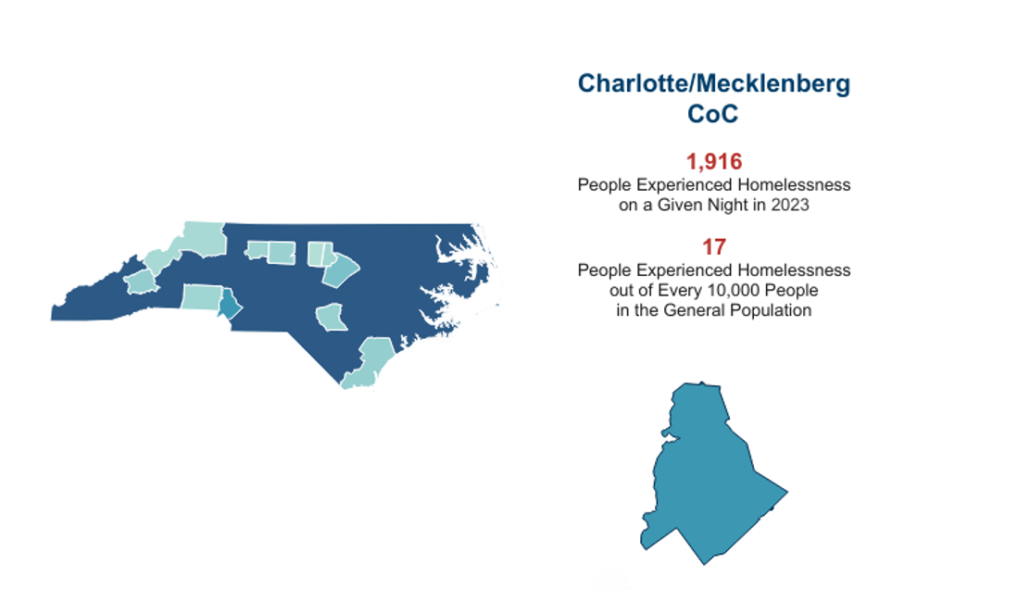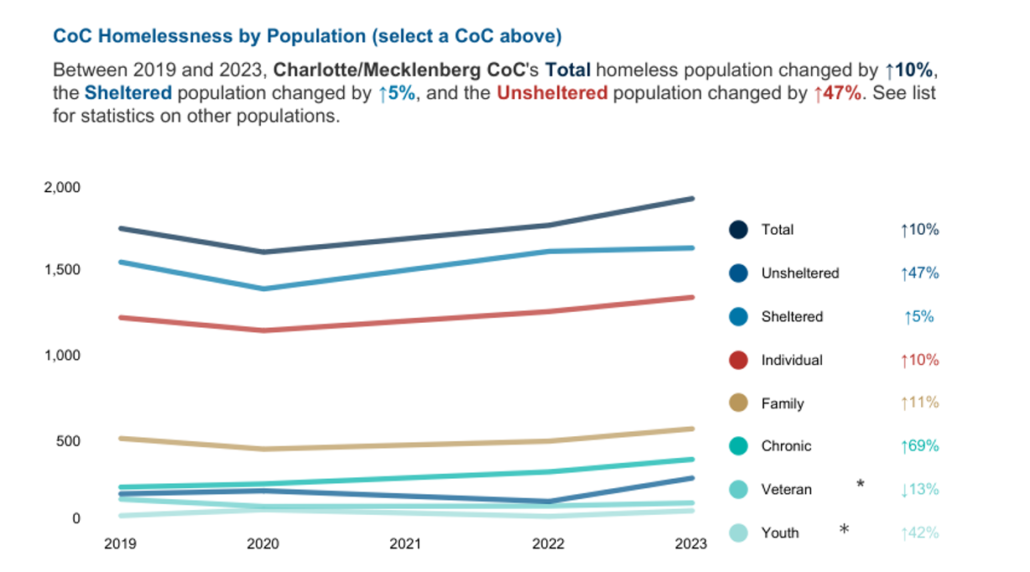National Alliance to End Homelessness:
2024 State of Homelessness Report
Mary Ann Priester
Senior Management Analyst
Mecklenburg County Community Support Services
On August 5, 2024, the National Alliance to End Homelessness released their 2024 State of Homelessness report. This report, published annually, not only provides a national overview of homelessness but also includes several interactive tools that allow the reader to drill down to the state and Continuum of Care levels. It includes data on demographic characteristics of people experiencing homelessness, rates of people experiencing homelessness, and the number of beds available for people experiencing homelessness.
This blog highlights key findings from the report with a focus on state and local data.
ABOUT THE REPORT
The National Alliance to End Homelessness (NAEH) State of Homelessness: 2024 Edition uses data from the 2023 U.S. Department of Housing and Urban Development’s (HUD) Point-in-Time (PIT) Count and Housing Inventory Count (HIC), Census Bureau, and the University of Minnesota’s Integrated Public Use Microdata Series (IPUMS USA) population data to provide a snapshot of homelessness and housing instability in the United States. The report also includes expert independent analysis. Together these data sources are used to examine risk for homelessness, who becomes homeless and why, where they live, and homelessness response system capacity.
Key Findings
- Nationally we are seeing record high numbers of people experiencing homelessness and record high numbers of people who are living unsheltered.
- In the past 5 years we have seen an increasing number of households who are experiencing homelessness for the first time.
- Despite system effectiveness and the addition of temporary and permanent housing beds to homeless response systems, the systems remain over capacity to meet a constant and consistently growing need.
STATE AND LOCAL DATA
Number and Rate of People Experiencing Homelessness
Based on PIT Count data, in North Carolina (NC), in 2023, on any given night, 9,754 persons were experiencing homelessness. That is, nine people out of every 10,000 people in the general population experienced homelessness. In Charlotte-Mecklenburg, on any given night in 2023, 1,916 people experienced homelessness with 17 people out of every 10,000 in the general population experiencing homelessness. Charlotte-Mecklenburg had the second highest estimate of people experiencing homelessness on any given night in 2023 with the highest estimate in the Balance of State Continuum of Care which consists of 79 counties (1,916 vs. 3,311). Charlotte-Mecklenburg also had the second highest rate of people experiencing unsheltered homelessness per 10,000 with the highest rate in the Asheville-Buncombe Continuum of Care (17 vs. 21).
Sheltered vs. Unsheltered Homelessness
Between 2019 and 2023, North Carolina’s total homeless population increased by 5% with a 10% decrease among those experiencing sheltered homelessness and a 52% increase among those experiencing unsheltered homelessness. There were also notable increases in the number of people who met the criteria for chronic homelessness (35%) and the number of unaccompanied youth (14%). Statewide there was also a 14% decrease in veteran homelessness. In Charlotte-Mecklenburg, the total homeless population increased 10% between 2019 and 2023 with a 5% increase among those experiencing sheltered homelessness and a 47% increase among those experiencing unsheltered homelessness. There was a 69% increase in chronic homelessness, a 42% increase in homelessness among unaccompanied youth, and an 11% increase in family homelessness. One bright spot is that there was a 13% decrease in veteran homelessness during this same time period.
Shelter Bed Capacity and Utilization
When examining shelter bed capacity and utilization across all of North Carolina on the night of the 2023 PIT, the state had 60% of the beds needed to shelter individuals who are living unsheltered, a deficit of 2,536 beds. For families with minor children, the state had 122% of the beds needed to shelter families with minor children living unsheltered. This means that statewide, there was enough capacity to shelter all families with minor children who were living unsheltered. When evaluating Charlotte-Mecklenburg data, the Continuum of Care had 86% of the beds needed to shelter individuals living unsheltered, a deficit of 192 beds. The Continuum of Care had 114% capacity to shelter families with children who are living outside which means there were adequate beds to shelter all families who were living unsheltered on the night of the 2023 PIT. Two important notes here. These data are from the 2023 PIT and there has been a significant increase in families with minor children who are living unsheltered in the 20 months since the 2023 PIT so these data might not reflect whether there is current capacity to shelter all families with minor children living unsheltered. It is also important to note that shelter and transitional housing beds often have eligibility and entry requirements. For example, some beds may only be able to serve veterans. Others may require that all adults in the household are working or for some, program entrance may be contingent on sobriety. These data reflect the number of available beds but we do not know if those who are living unsheltered meet the criteria to use the available beds so these percentages may overestimate the actual capacity of the system to shelter individuals and families with minor children.





